The smallest amongst Japan’s 47 prefectures, Kagawa Prefecture has many of its own specialties. Art enthusiasts will particularly enjoy Kagawa’s Naoshima and Teshima Island to admire beautiful artwork and get inspired. Blessed with resources, Kagawa also has many delicacies and must-buy souvenirs. Although small, Kagawa doesn’t lose to other prefectures. (ง'̀-'́)ง
Table of Contents
- The Smallest Prefecture in Japan - Kagawa-ken
- Checking out the Prefectural Attractions
- Kagawa Must Eat!
- Take-home Souvenirs
- Summary
The Smallest Prefecture in Japan - Kagawa-ken

History of Kagawa-ken
Kagawa Prefecture is a great archaeological wonder. Particularly in the areas of Kotohira, Zentsuji, and Shodoshima where numerous signs of prehistoric life and early human civilization were found leading to excavations in the area. Some of the notable discoveries include:
-
Shodoshima
Traces of human activities and mammoths from 30,000 years ago. At this time, the majority of Kagawa Prefecture, including the capital city Takamatsu, was submerged under the ocean. -
Mountain Area
Palaeolithic era, or “Old Stone Age” and Jomon Period, tools discovered - arrows, earthenware, and stoneware. -
Takuma-cho
Fully intact Jomon Period pottery. -
Kotohira
Indications of strong religious belief from animism to Shintoism. Tools for religious ceremonies were excavated including dotaku (ritual bells) and doken (swords). There are also signs of worshipping Mt. Kompira around the 1st millennium BC. -
Zentsuji
Discoveries of numerous religious artifacts dating back to the Yayoi, and Kofun Period; 250 BC to 552 AC. Findings included dotaku, donzen, bronzeware, burial mounds, religious artifacts, and more.
As time gradually passed, Shinto shrines and housing were built. Buddhism was introduced resulting in the building of temples and new religious artifacts. Sometime in the mid-5th century, the individual places were combined and named the Sanuki Province which would later become the present day Kagawa-ken.
※ Humanities Commons, "Kagawa: A Guide to Sanuki, Gateway to Shikoku," p.3, 5-6 ※ Encyclopædia Britannica, Inc., "Kagawa"
Geography and Population
Kagawa Prefecture is the smallest of 47 prefectures in Japan, measuring about 1,876 square kilometers in area. Kagawa is a coastal prefecture with the north stretch facing the Seto Inland Sea that separates the Shikoku Region from Honshu and Kyushu Regions. South Kagawa borders Tokushima Prefecture, the area is mostly mountainous with the Sanuki Mountain Range running horizontally through it. Near the northern coast is a flat outstretch of land called the Sanuki Plain. Takamatsu, as the capital city, is a popular tourist spot.
As a southern prefecture, Kagawa enjoys a mild warm climate with lots of bright sunny days and infrequent rain. According to the Reiwa 2nd Year (or 2020) Census, the population stands at around 951,049.
※ Encyclopædia Britannica, Inc., "Kagawa" ※ EU-Japan Centre, "Kagawa Prefecture" ※ Kagawa Prefectural Government, "Reiwa 2nd Year Census Kagawa Prefectural Bulletin"
Economy
Thanks to its climate and long stretches of beaches, Kagawa is ideal for processing salt. Hence, its title of “Salt Kingdom Kagawa” for being the largest salt producer in Japan.
※ Kagawa Prefectural Product Promotion Organization, “Kagawa Prefecture Products: Salt” ※ EU-Japan Centre, "Kagawa Prefecture"
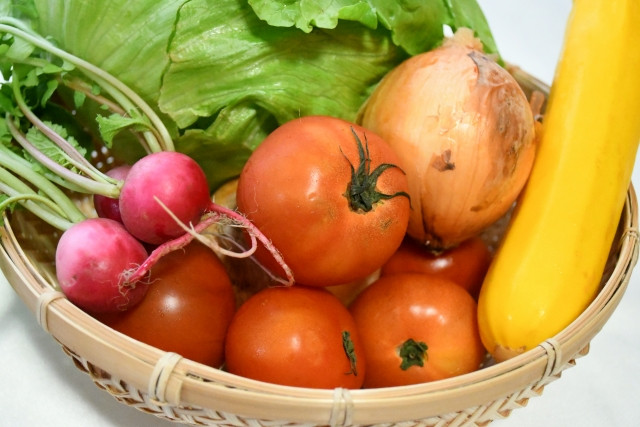
Kagawa’s main economic activity is in agriculture. They are well known for high quality produce especially their patented crops including:
-
Sanuki Yoimai Rice for sake
-
Sanuki no Yume 2013 for Sanuki Udon
-
Sanuki Hime Strawberries
-
Sanuki Gold Kiwi
Kagawa is also the No.1 Producer in Japan for the following:
-
Red Carrots
-
Olives
-
Marguerite
Aside from crops, Kagawa’s other booming agriculture include cattling, fishing, yellowtail fish farming, and meat production.
K.Brand
How does Kagawa guarantee the quality of so many kinds of produce?
If you are wondering about this, Kagawa has implemented a K.Brand system. The Council to Promote Distribution and Consumption of Kagawa Products only grants the K.Brand Status to products that fulfill the check for quality, unique production system, and speciality.
※ EU-Japan Centre, "Kagawa Prefecture" ※ Kagawa Profile, "Industry"
Writer's Pick
Checking out the Prefectural Attractions
Although a big prefecture offers many things to see and do, covering the entire prefecture can be time consuming, tiring, and costly. For travellers that are tired of scoring through pages of attractions, wrecking your brain thinking of which to add to your list; Kagawa makes planning an itinerary easy for you - just see them all! It’ll take a few days at most!
Marugame Castle
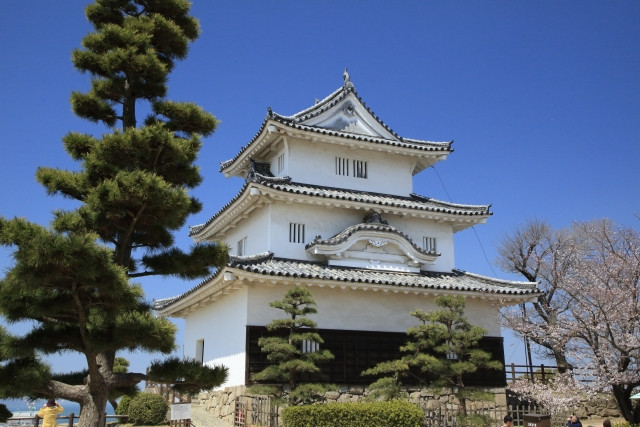
Marugame Castle offers a great view of Marugame City and the Seto Inland Sea. Majority of castles in Japan have been rebuilt from scratch, except for 12. Marugame Castle is one of these 12 with its original castle keep.
Construction of Marugame Castle first started in 1597, 10 years after the beginning of Ikoma Chikamasa’s rule of Sanuki Province (Old Kagawa Prefecture). The castle’s design was modeled after Azuchi Castle, located in Shiga Prefecture, which was owned by Oda Nobunaga. Unfortunately, the castle was demolished in 1615 due to the One Country, One Castle Policy (一国一城令) by the Tokugawa Shogunate. In 1641, construction began to reconstruct Marugame Castle which was completed in 1643.
After numerous renovations and destruction through the ages, the original castle keep and several gates are all that remains of the grand castle.
Aside from learning about the castle’s history, admiring the architecture, and enjoying the panoramic view from the castle, there are many more things you can do here. Create your own bamboo uchiwa (Japanese traditional fan) at the Uchiwa Workshop, or purchase an original design uchiwa as a souvenir. If you’re visiting during sakura season, Marugame Castle is one of the best cherry blossom viewing spots around town.
Access: 10-mins walk from JR Marugame Station
Entrance Fee: 200 yen (Adult)
※ JNTO, “Marugame Castle”
NOTE
Uchiwa Workshop is closed on Wednesdays.
For the Art Connoisseur
Kagawa is an art lover’s haven, with three islands dedicated to appreciating art; Naoshima, Teshima, and Inujima Island. The 3 islands of art are the result of two mens’ dreams: the founder of Fukutake Publishing and the mayor of Naoshima.
※ Benesse Art Site Naoshima, “History of Benesse Art Site Naoshima”
Recommended for art admirers, enjoy the collection of art and get some inspiration to make your own.
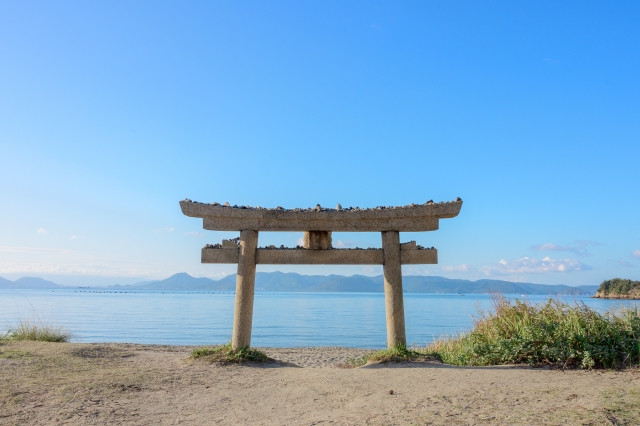
Naoshima Island
The start of Benesse Art Site Naoshima, Naoshima Island is famous for embracing art with its many modern art museums:
Benesse House Museum
Both an art museum and a hotel with large glass windows to enjoy the natural landscapes and seascape. Not limited to a canvas, in Benesse House Museum art crosses the boundaries of paper and impedes into every crevice of the building. From the walls, to modern art pieces, and to an outdoor hot bath that embraces the principles of feng shui as it overlooks the sea.
Entrance Fee: 1,050 yen or free for hotel guests
Chichu Art Museum
A museum designed and built with nature in mind. Most of the building is underground to reduce its effect on the environment and natural surroundings. The Chichu Garden is designed with the image of Impressionist artist Claude Monet’s artwork in mind, bringing his paintings to life. The artist's work can also be found in the museum for easy comparison.
Entrance Fee: 2,100 yen
Art House Project
An ongoing project that transforms abandoned buildings in Homura district into works of wonder.
Naoshima Bath I ♡ Yu
A unique experience where you can admire art whilst bathing. Naoshima Bath is a sento (public bath) bursting in colors and design.
Entrance Fee: 660 yen (Adult)
And more!
※ Benesse Art Site Naoshima, “About Naoshima Island”
Teshima Island

The art attractions on Teshima Island include:
Teshima Art Museum
Teshima Art Museum is the satisfying result when art and architecture come together. Resembling a droplet of water, the museum building is an art piece by itself. Unsurprisingly, “water” is the theme of the museum. Enjoy a tranquil and peaceful time at the museum accompanied by the bubbling, trickling sounds of water.
Entrance Fee: 1,570 yen
Tom Na H-iu
Inspired by a Celtic legend about spirit migration, artist Mariko Mori brings us a truly breathtaking sculpture. Centred in the middle of a pond amidst a bamboo forest, the only word to describe this piece of art is “other-wordly”.
Entrance Fee: 300 yen
Les Archives du Cœur
A unique museum for listening. Not to music, but to people’s heartbeats. Artist Christian Boltanski has been since 2008 recording heartbeats of people all over the world. You can also add your own heartbeat to the collection.
Entrance Fee: 520 yen
Recording Fee: 1,570 yen inclusive of CD-booklet
La forêt des murmures
Another listening activity. Located atop Mt. Danyama is a windchime forest. Each windchime has an attaching transparent plastic strip with names of loved ones written on it in memory. When the wind blows, the windchimes erupt in a cacophony of tinkles.
Entrance Fee: None
Windchime Fee: 5,000 yen
※ Benesse Art Site Naoshima, “About Teshima Island”
Inujima Island
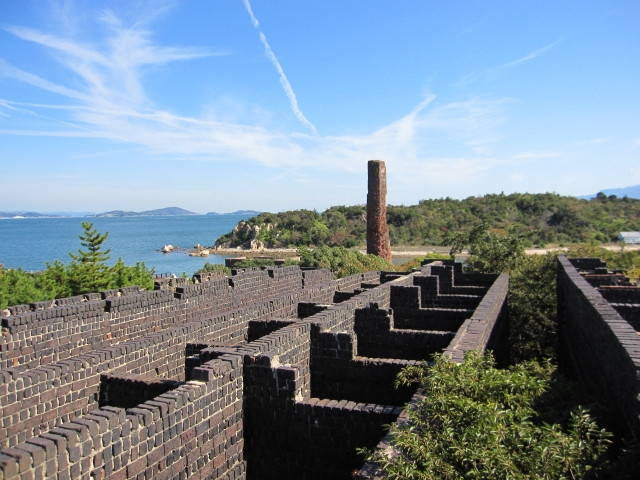
The art attractions on Inujima Island include:
Inujima Seirensho Art Museum
Inujima used to be a quarry area and heavily involved in copper smelting. The museum uses the old copper refinery as its stage. Visit the Inujima Ticket Center Cafe for a lunch break - enjoy the local cuisine whilst you enjoy the seaside view.
Entrance Fee: 2,100 yen inclusive of entry to Art House Project & Inujima Life Garden
Art House Project
Art blends with daily life with the Inujima Art House Project. At present, there are 5 “houses” with perhaps more to come.
※ Benesse Art Site Naoshima, “About Inujima Island”
Ritsurin Garden
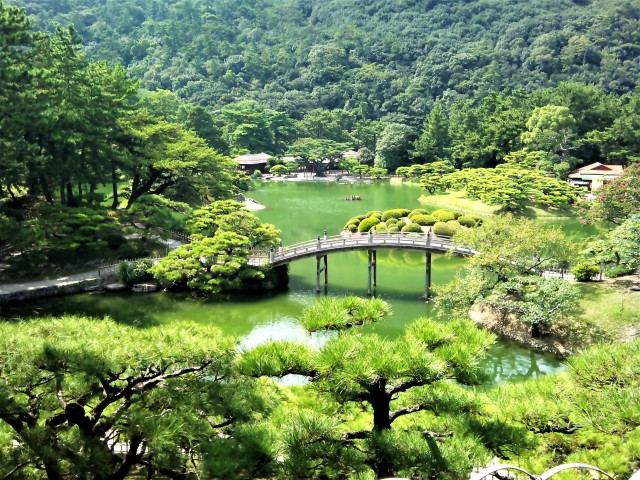
Ritsurin Garden was constructed during the Edo Period in the former garden of the Sato Clan which was developed by the Matsudaira Clan as their own private garden. In 1875, it was finally opened to the public and 78 years later, it was designated as a Special Place of Scenic Beauty in Japan. With about 75 hectares in area, it remains as the largest Cultural Property Garden of Japan. The highlights of the garden include pine trees with bonsai appearance, Hiraiho Hill with a great view over the pond, Wasen boat ride, ponds like Nanko Pond and Hokko, various teahouses including Kikugetsu-tei and Higurashi-tei where you can take a break, and more. You can also visit the Sanuki Folk Craft Museum that exhibits traditional tools and cultural relics of the ancient Sanuki civilization collected over the years.
-
3-mins walk from JR Ritsurin Koen Kitaguchi Station
-
1-min walk from Kotoden Ritsurin Koen Mae Bus Stop
Entrance Fee: 410 yen (Adult)
Other Fees:
-
Kikugetsu-tei : 700 yen (Adult) including matcha and wagashi, or 500 yen (Adult) including sencha and wagashi
-
Higurashi-tei : 500 yen (Adult) including matcha and wagashi
-
Boat Ride : 620 yen (Adult)
-
Audio Guide : 200 yen
※ Kagawa Prefecture Tourism Association, "Special Place of Scenic Beauty Ritsurin Garden"
Konzo-Ji
Konzo Temple (金倉寺) was built more than a thousand years ago in 774. Best known for being the birthplace of Enchin or Chisho Daishi who had greatly contributed to the growth of Tendai Sect. Buddhism during his lifetime. The temple worships Kishimojin (also known as Hariti) who is closely related to Kannon and the guardian deity of women and children. This is why many people visit the temple to pray for children and safe delivery during childbirth.
The temple’s highlight is the Eleven Faced Kannon made by Chisho Daishi. The temple is also the 76th temple along the Shikoku Pilgrimage.
Access: 8-mins walk from JR Konzoji Station on the Dosan Line
Okubo-Ji

Okubo-Ji (大窪寺), being the 88th temple, is the final stop for many on the journey that is the Shikoku Pilgrimage aka Shikoku88. Here, they leave their walking sticks as a sign of having completed their vows.
In the underground chamber of the temple, there are miniature forms of the Shikoku Pilgrimage route’s 88 temples. Here, visitors can perform the osana-fumi (sand stepping) around the mini-temples. It is believed that by doing so, one can receive the same benefits as completing the Shikoku88 circuit.
Access: Only with car.
※ Organization for Promotion of Tourism in Shikoku, "Okoboji Temple"
Kagawa Must Eat!
Other than the nest of historical and cultural sites available, Kagawa has just as many if not more restaurants to offer the best of Kagawa cuisine! Here are some specialties you must try.
Udon
Just as you can’t visit Aomori without trying their apples, the same goes for Kagawa and its Udon. Udon prefecture Kagawa specializes in making udon so you are guaranteed to have some of the best udon you can ever find in Japan.
Yamagoe Udon
Although udon is available all over Kagawa, if time permits visit Yamagoe Udon, a restaurant-turned udon wholesaler. Operating since 1941, Yamagoe Udon offers only freshly made quality udon. There are 8 menu items including their original udon menu - Kamatama. Kamatama udon consists of hot udon noodles, raw egg, yam, and a special dashi.
Access: 3-mins walk from Hayu-kakami Bus Station on the Sakaide Ayakawa Bus Line towards Tomikuma Nishioki
Mendokoro Wataya
An udon specialty restaurant, Mendokoro Wataya is most famous for its Niku udon (beef udon). Operating since 1948, the restaurant is a family business now operated by its third generation. It first opened as “Wataya Shokudo”, a catering company supplying bento to offices. With the success and subsequent expansion of their business, they started serving udon noodles alongside bentos in 1989. FInally in 1997, the first Mendokoro Wataya specializing in udon was born in Nishihirayama. At the moment, they have 2 operating stores; Marugame, and Takamatsu.
Hamachi
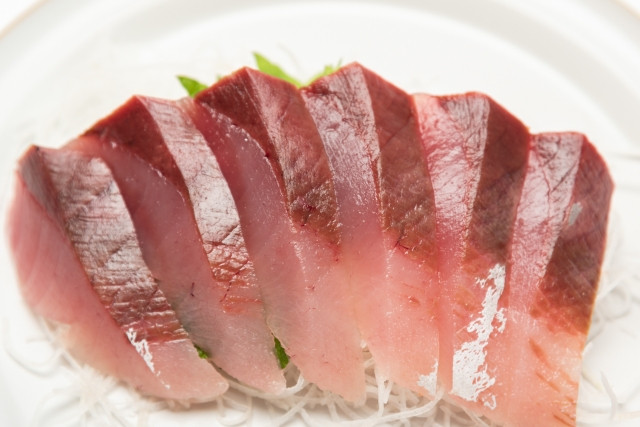
Hamachi (yellowtail amberjack) is Kagawa’s prefectural fish. Visit Sanuki Sake Vegetable Kirari to enjoy olive hamachi shabu-shabu course including unlimited drinks for 5,280 yen. Or try marinated hamachi-don (ハマチ漬け丼 Hamachizuke-don), a local favourite, at Seafood Restaurant Jakoya. They also have olive hamachi when it is in season.
Olive Wagyu
Just like olive hamachi, olive wagyu is a Wagaya specialty. Originating from Shodoshima, olive oil by-products are fed to cows resulting in excellent grade and quality of beef. For a selection of restaurants in Kagawa that serve olive beef, check this list.
※ Olive-Fed Wagyu Beef
Take-home Souvenirs
Commemorate your trip around Kagawa with some souvenirs. Bring home some as a gift to share a piece of Kagawa with family and friends.
Kawara Senbei
Kawara Senbei is a wagashi shaped to resemble roof tiles. It is made from flour and Sanuki Shirashita sugar instead of the classic round senbei crackers made from rice.
Grape Mochi
Also known as Budomochi, it is not actually made from grapes. It is made from red bean paste rolled and wrapped in mochi, then steamed. Its appearance resembles that of grapes.
Shoyu Soybeans
Kagawa Prefecture has a long history in soy sauce production which is thanks to their quality soybeans. A unique Kagawa snack is shoyu soybeans. As its name implies, it is literally soybeans marinated in shoyu and sugar. You can buy them at Kurokawa Processed Food Co., Ltd. in Takamatsu City as well as plenty of other shops.
Sanuki Udon
If you are wondering whether you can bring back some sanuki udon as a souvenir, then wonder no further because yes you can. You can find Sanuki Udon in grocery stores and souvenir shops all over Kagawa.
Summary
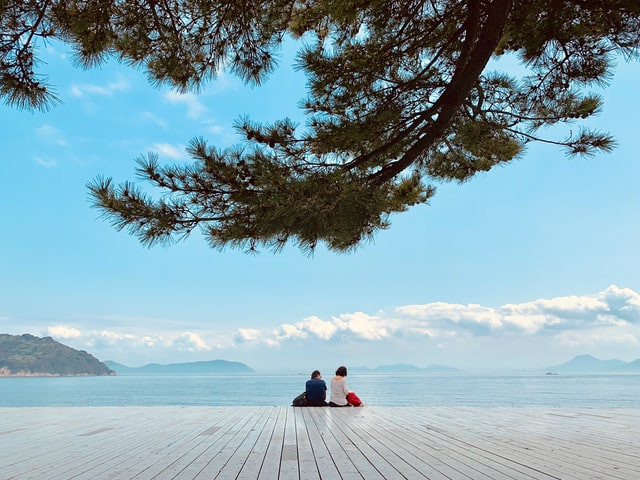
Small is powerful! Kagawa Prefecture does not let it’s size predicate itself. Maximizing its resources, every end and corner of Kagawa is filled with things to do. In fact, there are still so many things left we can recommend. But there’s no fun in having everything served to you on a platter, so get out there and explore Kagawa Prefecture for yourself!












.png)
















